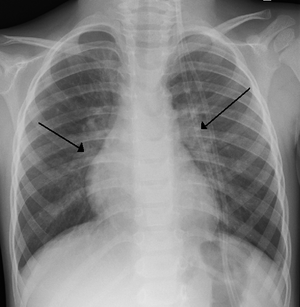Bronchiolitis
| Bronchiolitis | |
|---|---|
 |
|
| An X-ray of a child with RSV showing the typical bilateral perihilar fullness of bronchiolitis. | |
| Classification and external resources | |
| Specialty | pulmonology |
| ICD-10 | J21 |
| ICD-9-CM | 466.1 |
| DiseasesDB | 1701 |
| MedlinePlus | 000975 |
| eMedicine | emerg/365 |
| Patient UK | Bronchiolitis |
| MeSH | D001988 |
Bronchiolitis is inflammation of the bronchioles, the smallest air passages of the lungs. It usually occurs in children less than two years of age with the majority being aged between three and six months. It presents with coughing, wheezing and shortness of breath which can cause some children difficulty in feeding. This inflammation is usually caused by respiratory syncytial virus (70% of cases) and is much more common in the winter months.
Treatment is typically supportive with oxygen, monitoring, fluid and nutrition (by gastric tube or intravenously). The use of nebulized hypertonic saline is controversial with some reviews finding benefits and others not. There is insufficient evidence to support treatment with antibiotics, surfactant, chest physiotherapy, bronchodilators or nebulized epinephrine. Bronchiolitis is common, with up to one third of children being affected in their first year of life.
In a typical case, an infant under two years of age develops cough, wheeze, and shortness of breath over one or two days. Crackles or wheeze are typical findings on listening to the chest with a stethoscope. The infant may be breathless for several days. After the acute illness, it is common for the airways to remain sensitive for several weeks, leading to recurrent cough and wheeze.
Some signs of severe disease include:
The term usually refers to acute viral bronchiolitis, a common disease in infancy. This is most commonly caused by respiratory syncytial virus (RSV, also known as human pneumovirus). Other viruses which may cause this illness include metapneumovirus, influenza, parainfluenza, coronavirus, adenovirus, and rhinovirus.
...
Wikipedia
